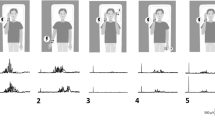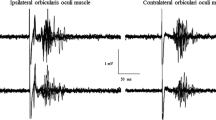Summary
In three, normal, human subjects, tobacco smoking was used as a pharmacological probe to modify differentially the direct and indirect pathways underlying the blink reflex. The latency of the indirect R2 component of the orbicularis oculis electromyogram evoked by electrical stimulation of the trigeminal supraorbital nerve transiently increased 20–80% after smoking, while the latency of the shorter latency, direct R1 component remained constant. The magnitude of both components of the blink reflex transiently decreased. The data demonstrate that tobacco smoking can differentially alter the long and short latency components of the blink reflex, and suggest that these effects result from modifications of central pathways sensitive to nicotine.
Similar content being viewed by others
References
Boiardi A, Bussone MR, Caccia R, Rocca E (1975) Electrophysiological evidence for a neurohormonal dependence in the changes of the late glabellar response in man. Eur Neurol 13: 513–518
Bollen E, Arts RJHM, Roos RAC, Van Der Velde EA, Buruma OJS (1986) Brainstem reflexes and brainstem auditory evoked responses in Huntington's chorea. J Neurol Neurosurg Psychiat 49: 313–315
Caraceni T, Avanzini G, Spreafico R, Negri S, Broggi G, Girotti F (1976) Study of the excitability cycle of the blink reflex in Huntington's chorea. Eur Neurol 14: 465–472
Clarke PBS, Hommer DW, Pert A, Skirboll LR (1985) Electrophysiological actions of nicotine on substantia nigra single units. Br J Pharmocol 85: 827–835
Esteban A, Mateo D, Gimenez-Roldan S (1981) Early detection of Huntington's disease. Blink reflex and levadopa load in presymptomatic and incipient subjects J Neurol Neurosurg Psychiat 44: 43–48
Evinger C, Manning KA (1988) A model system for motor learning: adaptive gain control of the blink reflex. Exp Brain Res 70: 527–538
Ferguson IT, Lenman JAR, Johnston BB (1978) Habituation of the orbicularis oculi reflex in dementia and dyskinetic states. J Neurol Neurosurg Psychiat 41: 824–828
Grunwald F, Schrock H, Kuschinsky W (1987) The effect of acute nicotine infusion on the local cerebral glucose utilization of the awake rat. Brain Res 400: 232–238
Hunt S, Schmidt J (1978) Some observations on the binding patterns of a-bungarotoxin in the central nervous system of the rat. Brain Res 157: 213–232
Kimura J (1983) Clinical uses of the electrically elicited blink reflex. In: Desmedt JE (ed) Motor control mechanisms in health and disease. Raven Press, New York, pp 773–786
Leigh RJ, Zee DS (1983) The neurology of eye movements. FA Davis, Philadelphia
Lowitzsch K, Luder G (1985) Habituation of the blink reflex: computer assisted quantitative analysis. Electroencephal Clin Neurophysiol 60: 525–531
Manning KA, Evinger C (1986) Different forms of blinks and their two-stage control. Exp Brain Res 64: 579–588
Ongerboer de Visser BW (1983) Comparative study of corneal and blink reflex latencies in patients with segmental or with cerebral lesions. In: Desmedt JE (ed) Motor control mechanisms in health and disease. Raven Press, New York, pp 757–772
Rimpel J, Geyer D, Hopf HC (1982) Changes in the blink responses to combined trigeminal, acoustic and visual repetitive stimulation, studied in the human subject. Electroencephal Clin Neurophysiol 54: 552–560
Roughton FJW (1945) The average time spent by blood in the human lung capillary and its relation to the rates of CO uptake and elimination in man. Am J Physiol 143: 621–633
Russell MAH, Jarvis M, Iyer R, Feyerabend C (1980) Relation of nicotine yield of cigarettes to blood nicotine concentrations in smokers. Br Med J 280: 972–976
Schievelbein H (1984) Nicotine, resorption and fate. In: Balfour DJK (ed) Nicotine and the tobacco smoking habit. Pergamon, Oxford, pp 1–15
Schneider JS, Denaro FJ, Lidsky TI (1982) Basal ganglia: motor influences mediated by sensory interactions. Exp Neurol 77: 534–543
Sibony PA, Evinger C, Manning KA (1987a) Tobacco-induced primary-position upbeat nystagmus. Ann Neurol 21: 53–58
Sibony PA, Evinger C, Manning KA (1987b) Effects of tobacco on pursuit eye movements and blinks. Invest Ophthalmol Vis Sci 28: 316
Author information
Authors and Affiliations
Rights and permissions
About this article
Cite this article
Evinger, C., Sibony, P.A., Manning, K.A. et al. A pharmacological distinction between the long and short latency pathways of the human blink reflex revealed with tobacco. Exp Brain Res 73, 477–480 (1988). https://doi.org/10.1007/BF00406604
Received:
Accepted:
Issue Date:
DOI: https://doi.org/10.1007/BF00406604




